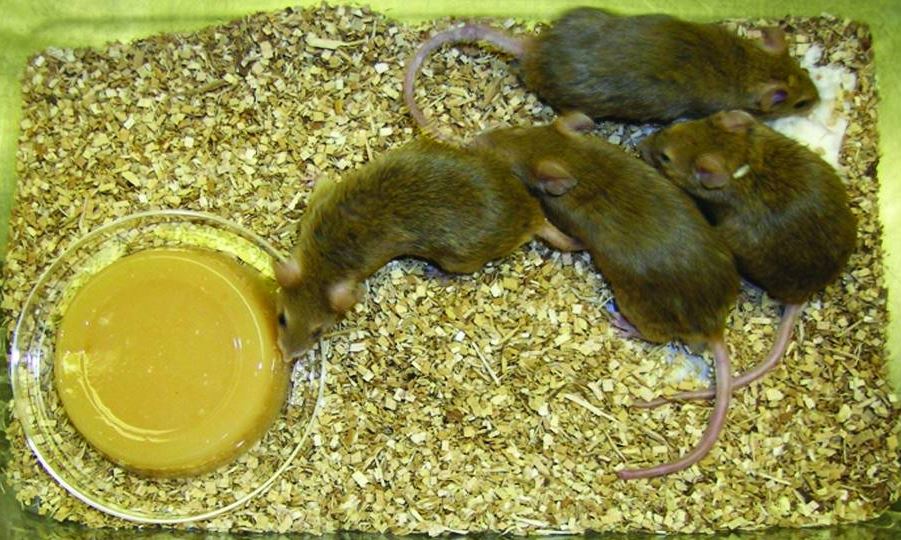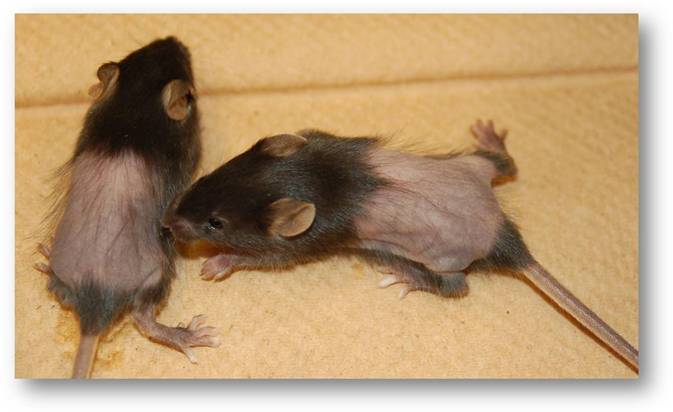Irradiation in rodents, by Gamma or Xrays, is often used in the fields of immunology, toxicology and oncology. Irradiation causes breaks in the DNA, targeting primarily rapidly dividing cells, including those in the haematopoietic system (bone marrow, spleen, thymus and lymph nodes) and the gastrointestinal tract.
The cells of the immune system are among the most highly radiosensitive cells in the body. The most common goal of irradiation in rodents is to damage the immune system, rendering the animals immunosuppressed for engraftment of tumors or hematopoietic stem cells. Various strains of mice show different sensitivity to radiation: for example, BALB/c and SCID mice require lower dosages while C57BL/6 are more radioresistant.
Irradiation can provoke the translocation of bacteria from the gastrointestinal tract to the blood stream, causing severe bacteremia and sepsis, a life threatening systemic infection throughout the entire body. Oral administration of antibiotics may minimize bacterial contamination and decrease infections. Start the treatment a few days before irradiation, and for at least 14 days and up to 28 days post-irradiation.
Antibiotics such as Baytril, Ampicillin and Sulfamethoxazole-Trimethoprim (TMS) are recommended drugs for the treatment of irradiated mice. However, some antibiotics are quite bitter and mice may refuse to consume them. Antibiotic delivery by injection requires repeated handling by trained technicians, and is stressful and painful to the animals.
ClearH2O products such as MediGel® Sucralose, MediDrop® Sucralose, and MediGel® Hazelnut are highly palatable oral delivery alternatives for antibiotics that animal care professionals have found very effective.
Irradiation induces damage to the intestinal epithelium and can cause diarrhea and dehydration in rodents. Providing mice easy access to water or hydration gels such as HydroGel® a water gel, or DietGel® Recovery, a nutritionally fortified water gel with electrolytes and sugars, will help replenish vital fluids, and improve survival rates and promote recovery from an otherwise lethal dose of radiation. In addition, utilizing these methods of hydration will circumvent the need for injections of saline solution. Many institutions have incorporated hydration supplement products as their standard of care of rodents post irradiation, such as University of Melbourne in Australia.
Exposure to ionizing radiation can cause lethal damage to the gastrointestinal (GI) tract, a condition called the radiation-induced GI syndrome, involving diarrhea, bacterial translocation, and hemorrhage that occurs when large areas of the intestine are irradiated. Another condition, Acute Radiation syndrome (ARS) following exposure to high dose ionizing radiation is associated with multiple severe systemic multi‐organ failures, including early effects related to bone marrow toxicity (hematopoietic syndrome) and gastrointestinal toxicity.
Therefore, weight of the mice post-irradiation has to be closely monitored. Due to the lack of appetite and the radiation-induced diarrhea, mice can lose up to 25% of their body weight in the first two weeks after irradiation. Weight loss is used as a parameter for endpoint criteria: a weight loss >25% requires immediate euthanasia, losing precious mice for the study conducted.
Providing soft food during the recovery phase after irradiation is required by institutional Standards Operating Protocols (SOPs). Common methods for soft foods are :
A study by the Montreal Clinical Research Institute (IRCM) confirmed that the administration of DietGel® 76A to sub-lethal irradiated animals from three different transgenic mice strains (C57BL/6J, CD45.1 and NRG) over a period of 21 consecutive days post-irradiation have a significant impact on the clinical signs, body weight (see figure below) and the general survival rate of the animals.

Irradiated mice are severely immunosuppressed and need a complete sterile environment. After irradiation exposure, mice must be placed in a cage and kept clean and quiet. Sterilized caging, food, and water is recommended. For the first 14 days, they will experience irradiation related sickness, and must be checked daily.
To try a sample of any of ClearH2O product, simply fill out a sample request !
Image from Moccia et al. 2010
The cells of the immune system are among the most highly radiosensitive cells in the body. The most common goal of irradiation in rodents is to damage the immune system, rendering the animals immunosuppressed for engraftment of tumors or hematopoietic stem cells. Various strains of mice show different sensitivity to radiation: for example, BALB/c and SCID mice require lower dosages while C57BL/6 are more radioresistant.
- Use Antiobiotics
- Provide a Reachable Water Source
- Offer Soft Food
- Ensure Clean Housing
1- Use Antibiotics
Irradiation can provoke the translocation of bacteria from the gastrointestinal tract to the blood stream, causing severe bacteremia and sepsis, a life threatening systemic infection throughout the entire body. Oral administration of antibiotics may minimize bacterial contamination and decrease infections. Start the treatment a few days before irradiation, and for at least 14 days and up to 28 days post-irradiation.
Antibiotics such as Baytril, Ampicillin and Sulfamethoxazole-Trimethoprim (TMS) are recommended drugs for the treatment of irradiated mice. However, some antibiotics are quite bitter and mice may refuse to consume them. Antibiotic delivery by injection requires repeated handling by trained technicians, and is stressful and painful to the animals.
ClearH2O products such as MediGel® Sucralose, MediDrop® Sucralose, and MediGel® Hazelnut are highly palatable oral delivery alternatives for antibiotics that animal care professionals have found very effective.
2- Provide a Reachable Water Source
Irradiation induces damage to the intestinal epithelium and can cause diarrhea and dehydration in rodents. Providing mice easy access to water or hydration gels such as HydroGel® a water gel, or DietGel® Recovery, a nutritionally fortified water gel with electrolytes and sugars, will help replenish vital fluids, and improve survival rates and promote recovery from an otherwise lethal dose of radiation. In addition, utilizing these methods of hydration will circumvent the need for injections of saline solution. Many institutions have incorporated hydration supplement products as their standard of care of rodents post irradiation, such as University of Melbourne in Australia.
3- Offer Soft Food
Exposure to ionizing radiation can cause lethal damage to the gastrointestinal (GI) tract, a condition called the radiation-induced GI syndrome, involving diarrhea, bacterial translocation, and hemorrhage that occurs when large areas of the intestine are irradiated. Another condition, Acute Radiation syndrome (ARS) following exposure to high dose ionizing radiation is associated with multiple severe systemic multi‐organ failures, including early effects related to bone marrow toxicity (hematopoietic syndrome) and gastrointestinal toxicity.
Therefore, weight of the mice post-irradiation has to be closely monitored. Due to the lack of appetite and the radiation-induced diarrhea, mice can lose up to 25% of their body weight in the first two weeks after irradiation. Weight loss is used as a parameter for endpoint criteria: a weight loss >25% requires immediate euthanasia, losing precious mice for the study conducted.
Providing soft food during the recovery phase after irradiation is required by institutional Standards Operating Protocols (SOPs). Common methods for soft foods are :
- Powdered chow mixed with water to form a mash. The disadvantage of this method is that it takes up valuable technician time, and can become moldy quickly.
- Moistened feed pellets will typically dry up very quickly and are not recommended
- Nutritionally fortified gel supplements, such as DietGel® 76A , DietGel® 31M and DietGel® Boost, are ready to use alternatives, and provide the mice with all essential nutrients such as protein, fat, carbs, fiber, vitamins and minerals. Both DietGel® 76A and DietGel® 31M combine both hydration and nutrition in one serving, while DietGel® Boost is a high fat, high calorie gel great for weight loss.
A study by the Montreal Clinical Research Institute (IRCM) confirmed that the administration of DietGel® 76A to sub-lethal irradiated animals from three different transgenic mice strains (C57BL/6J, CD45.1 and NRG) over a period of 21 consecutive days post-irradiation have a significant impact on the clinical signs, body weight (see figure below) and the general survival rate of the animals.

4- Ensure Clean Housing
Irradiated mice are severely immunosuppressed and need a complete sterile environment. After irradiation exposure, mice must be placed in a cage and kept clean and quiet. Sterilized caging, food, and water is recommended. For the first 14 days, they will experience irradiation related sickness, and must be checked daily.
To try a sample of any of ClearH2O product, simply fill out a sample request !
Image from Moccia et al. 2010




Leave a comment
All comments are moderated before being published.
This site is protected by hCaptcha and the hCaptcha Privacy Policy and Terms of Service apply.